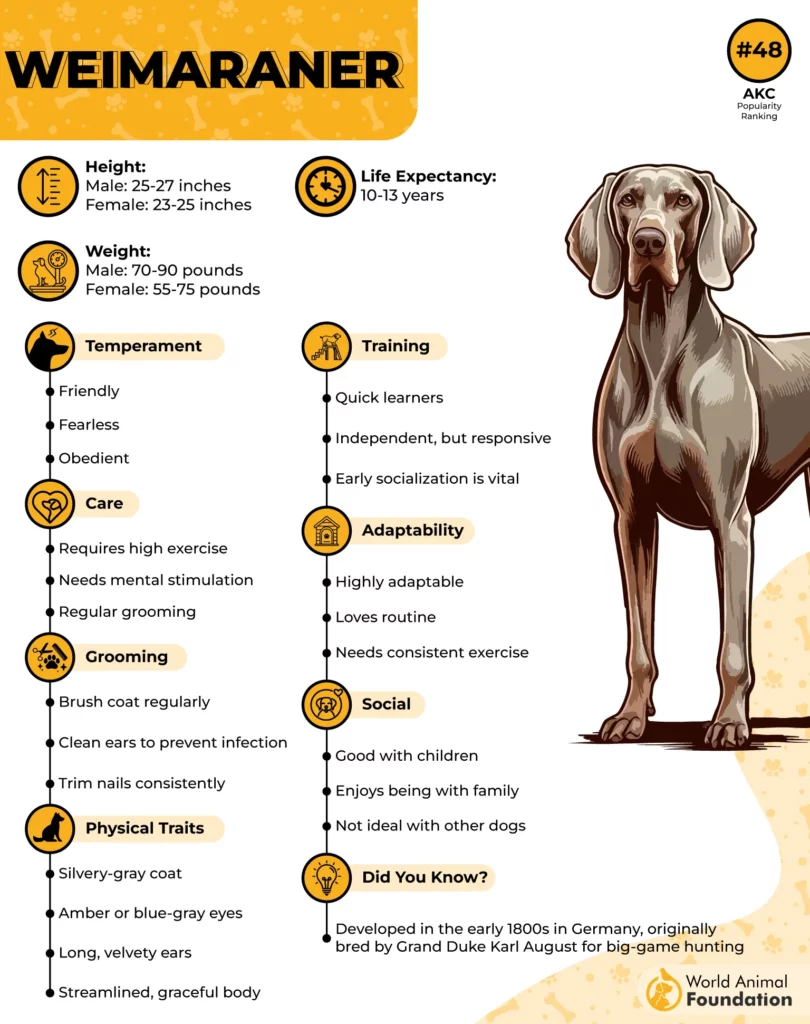When it comes to selecting a high-energy, affectionate, and intelligent dog, two breeds often come to mind: the Vizsla and the Weimaraner. Both are strikingly beautiful, with sleek coats, athletic builds, and devoted personalities. However, despite their similarities, they also have key differences that can make one a better fit for your lifestyle than the other.
The Vizsla, often called the “Velcro dog,” thrives on human companionship and is known as an eager-to-please and affectionate dog. In contrast, the Weimaraner is a larger, more independent breed that, while loyal, often requires a firm, experienced hand in training. Understanding their size, temperament, training needs, and care differences can help you make the best decision for your family.
Vizsla vs. Weimaraner
Vizsla vs. Weimaraner: Size Comparison
One of the most noticeable differences between the Vizsla and the Weimaraner is size. Both breeds share a sleek, athletic build and were originally bred for hunting, making them highly capable working dogs. However, the Weimaraner is significantly larger, giving it a more commanding presence and requiring more space and strength to manage.
Feature |
Vizsla |
Weimaraner |
|---|---|---|
|
Height |
21–24 inches |
23–27 inches |
|
Weight |
44–60 lbs |
55–90 lbs |
|
Build |
Lean, athletic |
Muscular, powerful |
According to the AKC, the Vizsla has a lean, lightweight frame that enhances speed and agility while maintaining the strength needed for physically demanding activities. Their smaller size makes them easier to handle while still being highly energetic and athletic.

Bred for endurance, they excel in running, hiking, and fieldwork activities. Their friendly nature and eagerness to please make training a smooth process, especially when using positive reinforcement. This breed thrives in environments with ample exercise, mental stimulation, and companionship.

The Weimaraner has a muscular build and imposing stature, giving it a strong, powerful presence. With high endurance and physical capability, this breed requires space to move freely and benefits from an active lifestyle. Their intelligence and drive make them quick learners, but they require firm and consistent training to manage their strong-willed nature, as stated by PetMD.
They can become restless and develop unwanted behaviors without proper exercise and mental engagement. Highly loyal and protective, the Weimaraner bonds closely with its owners and prefers not to be left alone for long periods.
Vizsla vs. Weimaraner: Personality and Temperament
Both breeds are affectionate, intelligent, and energetic, but they express their loyalty and devotion differently.
The Vizsla is famous for being a “Velcro dog,” meaning they thrive on human companionship and want to always be by your side. They are friendly, gentle, and incredibly affectionate. Their social nature makes them excellent for families, as they get along well with children and other pets. However, this constant need for attention can lead to separation anxiety if left alone for too long.

On the other hand, the Weimaraner is also loving but tends to be more independent. They form strong bonds with their owners but can be stubborn and strong-willed. This breed is naturally protective, making them a better choice for those looking for a watchdog.
However, their protective instincts also mean they need early socialization to prevent aggressive tendencies toward strangers. While the Weimaraner is affectionate with its family, it is not quite as clingy as the Vizsla and may prefer a bit more personal space.
The Vizsla is the best choice if you want a dog that will follow you everywhere, cuddle, and always seek your attention. The Weimaraner might be the right fit if you prefer a still affectionate dog with a stronger, more independent personality with natural guarding instincts.
Vizsla vs. Weimaraner: Training and Intelligence
Both the Vizsla and Weimaraner are highly intelligent dogs that can learn quickly, but they have different training styles and challenges.
Training Aspect |
Vizsla |
Weimaraner |
|---|---|---|
|
Trainability |
Eager to please, learns quickly |
Intelligent but can be stubborn |
|
Best Training Method |
Positive reinforcement, consistency |
Firm leadership, clear boundaries |
|
Obedience Level |
High |
Moderate (if not properly trained) |
The Vizsla is incredibly eager to please, which makes training relatively easy. They respond well to positive reinforcement, and their gentle nature means they do best with encouragement rather than harsh corrections. Consistency is key, as they thrive on routine and structure.
The Weimaraner, however, is smart but also more stubborn. This breed requires a firm, experienced owner who can establish clear leadership. Weimaraners may become dominant if not properly trained, leading to behavioral issues. They are strong-willed and require consistent, structured training from an early age. If left untrained, they can be destructive and difficult to manage.

The Vizsla is the easier choice for first-time dog owners or those looking for a cooperative and eager-to-please companion. The Weimaraner, while intelligent, requires a confident handler who can enforce boundaries.
Vizsla vs. Weimaraner: Health and Care Needs
Both the Vizsla and Weimaraner are generally healthy breeds, but they are prone to specific health issues.
Health Issue |
Vizsla |
Weimaraner |
|---|---|---|
|
Hip Dysplasia |
Yes |
Yes |
|
Bloat (Gastric Torsion) |
Rare |
High Risk |
|
Eye Issues |
Yes |
Yes |
|
Ear Infections |
Occasionally |
Occasionally |
|
Skin Allergies |
Sometimes |
Sometimes |
Hip dysplasia, a genetic condition that affects the hip joints, is common in both breeds and can lead to arthritis over time. Regular exercise, maintaining a healthy weight, and joint supplements can help manage this issue.
According to WebMD, one of the biggest concerns for Weimaraners is bloat (gastric torsion), a serious and potentially fatal condition where the stomach fills with gas and twists. This can occur if the dog eats too quickly, drinks excessive water after meals, or engages in strenuous activity right after eating. Preventive measures include feeding multiple small meals a day and avoiding vigorous exercise immediately before or after meals.

Both breeds have short, sleek, low-maintenance coats requiring minimal grooming. Weekly brushing helps control shedding and keeps their coat healthy, while occasional baths and regular ear cleaning can prevent infections and skin issues.
Vizsla vs. Weimaraner: Lifespan and Longevity
When considering a dog breed, lifespan is important, as it determines how long your furry companion will be part of your family. Both the Vizsla and Weimaraner are relatively long-lived breeds, but there is a slight difference in their average lifespans.
Feature |
Vizsla |
Weimaraner |
|---|---|---|
|
Lifespan |
12–14 years |
10–13 years |
On average, Vizslas live between 12 and 14 years, while Weimaraners tend to have a slightly shorter lifespan, typically 10 to 13 years. Several factors influence longevity, including genetics, diet, exercise, and overall health care.

Proper nutrition plays a crucial role in extending a dog’s life. Both breeds require high-quality, protein-rich diets to maintain muscle tone and energy levels. Feeding the right portions and ensuring they maintain a healthy weight can prevent obesity-related health issues that could shorten their lifespan.
Regular veterinary checkups are essential for the early detection of genetic conditions, especially in Weimaraners. Routine vaccinations, dental care, and parasite prevention also contribute to a longer and healthier life.
Exercise is another key factor. Both the Vizsla and Weimaraner are high-energy breeds that need daily physical and mental stimulation. Lack of exercise can lead to obesity, joint problems, and behavioral issues, all of which can impact their overall longevity.
While genetics play a role in lifespan, a well-cared-for dog—regardless of breed—has a much better chance of living a long, happy life. Owners who provide proper nutrition, healthcare, exercise, and mental enrichment can maximize the lifespan of their Vizsla or Weimaraner.
Conclusion
The Vizsla and Weimaraner are both hunting dogs and sporting breeds for their speed, agility, and intelligence. As sports dogs, they thrive in canine sports like agility, obedience, and field trials. Their active breed nature means they need plenty of exercise and mental stimulation to stay happy.
In terms of appearance, the Weimaraner is larger and more muscular, with a striking smooth coat in silver-gray, while the Vizsla’s coat is a sleek golden-rust. Both breeds are prone to hip and elbow dysplasia, so regular vet checkups are essential. Despite their high energy, they are good family dogs and can be a great family pet when properly trained and exercised.
For those who love both breeds, a Vizsla-Weimaraner mix offers a unique blend of their best traits. Whether you choose a Vizsla, Weimaraner, or another active breed, these loyal, affectionate dogs make outstanding companions for adventurous families.


